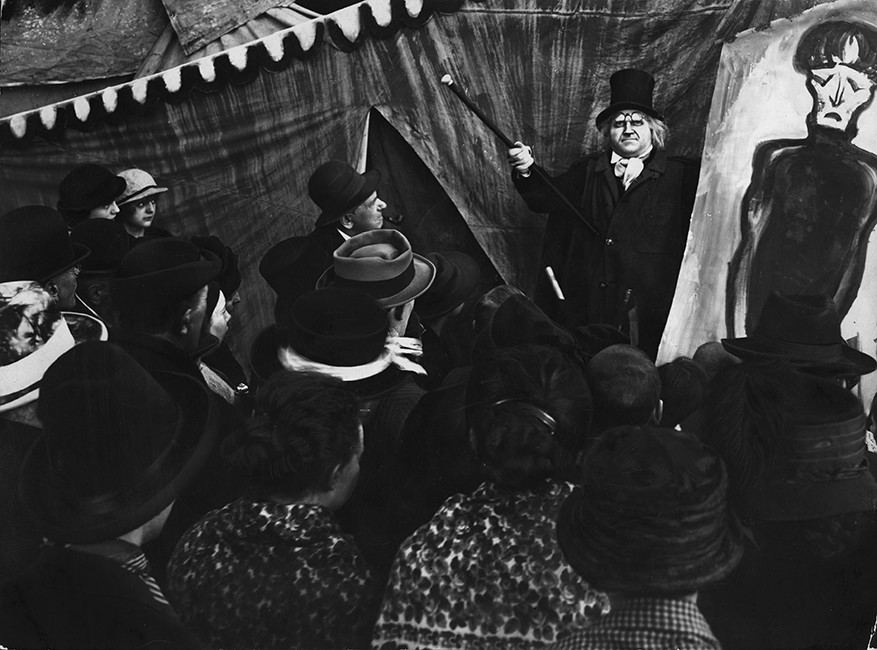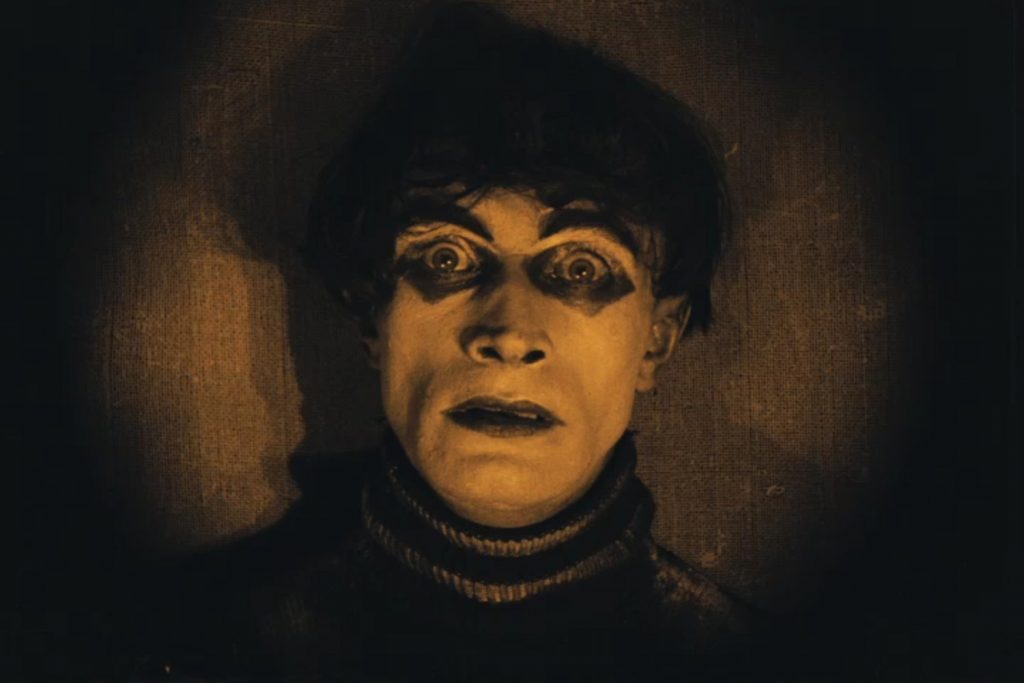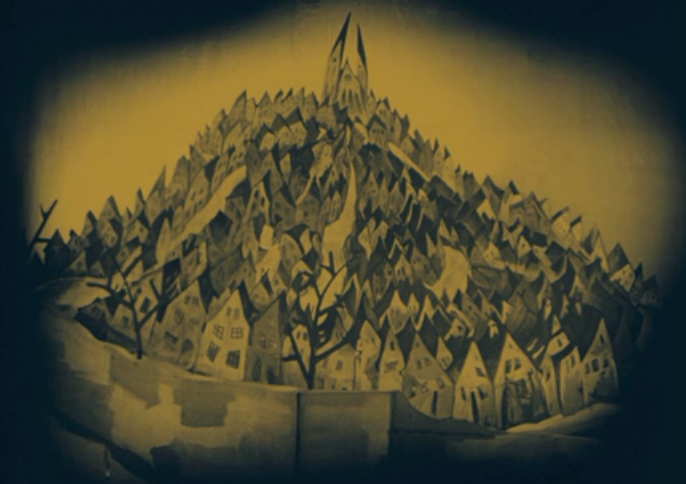The Cabinet of Dr. Caligari is often cited as the ‘granddaddy of modern horror films’. It takes the audience on an eerie journey through the mind of a madman. The conflict centers on a manipulative psychiatrist and the hero he has incarcerated in a lunatic asylum. Visually, the film offers a disturbing, skewed take on reality, heightened by the jagged asymmetry of the mise en scène. Although modern viewers might find the pace slow, with scenes consisting of long takes, The Cabinet of Dr. Caligari remains a stylish, imaginative, and deeply uncanny text, a century after it was made.
Caligari’s Origins
Like many other horror movies made after 1918, The Cabinet of Dr. Caligari represents the traumatized vision of war veterans. There was no way the filmmakers could literally depict the horrors of trench warfare – and still expect an audience to remain in the theatre. Realism – or the on screen realism available via the technology of the time – was simultaneously repulsive and not enough. Instead, postwar filmmakers accessed the distress and disassociation of returning soldiers through metaphors and symbols. Their dark truths were best communicated as Expressionist fables.
The Face At the Fairground
One of the Caligari screenwriters, Czech poet Hans Janowitz, drew on a haunting pre-war experience as the basis for the plot. He recalled following (stalking?) a pretty young woman around the Hamburg town fair one night in 1913. After losing her, he heard unearthly laughter coming from a clump of trees. He glimpsed the face of a man in the shadows, who quickly vanished. The next day it transpired that a murder had taken place at the fair – and the victim was a young woman named Gertrude. Convinced Gertrude was also the woman he’d followed, Janowitz attended her funeral. He claimed he recognized one of the mourners as being that face from the shadows.1
The Great War
Originally, the screenwriters intended The Cabinet of Dr. Caligari to be an attack on the authoritarian and militaristic German government. They had good reason. Back in 1914, the bellicose Kaiser Wilhelm II and his general staff exploited the crisis triggered by the assassination of Archduke Ferdinand. They backed the Austro-Hungarians’ sabre-rattling, seeing an opportunity to break the power of Russia to the east and France to the west.

This, they believed, would lead to German domination of the European bloc and expansion of the German empire in Africa. So, thinking they could win a swift, decisive ground war, the Imperial German army invaded Belgium on August 4, 1914. Instead, they precipitated global conflict.
Janowitz and Carl Mayer – like many other young poets and artists – interrupted promising careers to fight in the German army. Their initial dreams of Wagnerian glory were soon trampled in the Belgian mud. Four years later, millions of conscripted young Germans had suffered miserable deaths in the trenches – for nothing. After a humiliating defeat, Wilhelm, his superpower ambitions frustrated, abdicated. He left his country in financial, structural and emotional tatters.
Carnival
After the war, Janowitz and Mayer were both committed pacifists. Janowitz’s bitterness was particularly keen: He was given a dishonorable discharge from the army on psychiatric grounds. He returned to Berlin where, after the armistice, he met Mayer. Amid power cuts and food shortages they bonded over their shared hatred of the German officials who had sacrificed so many for so little. One night, they visited the carnival on Kantstraße. In one sideshow, a hypnotised strongman (“MAN or MACHINE?”) performed acrobatic feats and tossed predictions at the audience.2 When one of his predictions came true it gave Mayer and Janowitz the basics for their plot.
They wanted The Cabinet of Dr. Caligari to highlight the dangers of power-hungry authority. So, they crafted a story about a carnival hypnotist, Dr. Caligari, and his puppet, the somnambulist Cesare. Caught in a state neither asleep nor awake, Cesare must do his master’s bidding – even when it involves murder. A young man visiting the carnival, Francis, becomes suspicious when Cesare predicts his friend’s death, and then does everything in his power to uncover Caligari’s evil schemes.
In this initial rendition, the mountebank Caligari – like the Imperial government – seeks domination irregardless of the cost to human rights and freedoms. Cesare represents the countless soldiers who sleepwalked into battle, stripped of any individual agency. Their original ending exposes Dr. Caligari as a madman who must be subdued. It frames Francis as the principled hero and Cesare as an innocent victim. However, their version of the script didn’t make it onto the screen.
Robert Wiene and Expressionism
Director Robert Wiene, like his brother Conrad and many other filmmakers of the Weimar era, began his career in the theatre. Nonetheless, he had a keen sense of film as a distinctive artistic medium and understood that what entertained and engaged audiences on stage didn’t necessarily translate to the screen. In May 1919 he reread August Strindberg’s stageplay Miss Julie for his friend, the director Carl Meinhard, who was thinking of adapting it for film. Wiene advised against it. He thought the classic play, one of Strindberg’s early, naturalistic works, would make “a wooden, artless film without any literary or artistic merit.”3 Wiene, along with many other European filmmakers of the era, wanted to use film to push creative boundaries – and regenerate his country’s war-shattered culture.
The German Expressionist movement was active throughout the 1900s but had become passé in theatre by the end of the war. Nonetheless, it offered an aesthetic framework for exploring the aftermath of the trenches. Expressionism aims to elicit emotion by distorting reality. The physical shape of an object isn’t as important as how it makes you feel. Expressionists warped the world around them in order to convey their inner chaos.
Expressionist cinema of the early 1920s offers a skewed view of reality, full of high angles, forced perspectives, high contrast lighting, and artificial make-up. It also draws heavily on symbolism, spirituality, myth, and the new art of psychoanalysis. For Wiene and his producers, Expressionist production design was a way to push visual storytelling past what was possible in the theatre. They hired Expressionist painters Walter Reimann and Hermann Warm to create sets that would put the audience inside a character’s mind.

Psychological Horror
This is where Wiene clashed with the screenwriters. Mayer and Janowitz wanted The Cabinet of Dr. Caligari to be a straightforward crime story, a parable about oppression and manipulation, ending with the unmasking of the villainous Caligari. Even though Francis struggles to make others believe his claims about Caligari and Cesare, they turn out to be true and Caligari is brought to justice. Wiene preferred a more psychological approach – Freudian theories were hugely influential at the time. So, he added a framing narrative that entirely reverses this meaning, positioning Francis as the madman and Caligari as the kindly psychoanalyst, intent on curing him of his delusions.
Mayer and Janowitz were furious, understandably, and complained loudly. Most famously, they told their story to cultural critic Siegfried Kracauer. Kracauer made their original intentions part of his central thesis in his influential book, From Caligari to Hitler: A Psychological History of the German Film (1947). Although much of his thinking about the way the movies of the Weimar Republic paved the way for fascism has now been challenged, Kracauer’s take on Caligari as a predictive text dominated much 20th century discussion of the movie.
The Movie
The Cabinet of Dr. Caligari begins in a walled garden, with an old man and a younger sitting on a bench. Their conversation, out of the gate, is of the spirit world – and, right on cue an ethereal young woman (Lil Dagover) drifts past, seemingly unable to see or hear them. The younger man, Francis (Friedrich Fehér) claims this is his fiancée, and proceeds to tell the sad tale that brought them both to this point.

Francis’s hometown, Holstenwall is depicted as a series of parallelograms piled on top of one another. It’s wholly artificial, a complete re-imagining of a Northern German town. Roads, hills, houses and even trees take on a menacing new, anti-naturalistic shape. Stylised, sinuous, the actors (especially Conrad Veidt and Lil Dagover), move as symbols through the surreal landscape, their stark makeup enhancing the dreamlike sensation of the action.
In what has subsequently become a well-worn horror trope, Francis pins the beginning of his troubles to the day the carnival comes to town. One of the showmen, a top-hatted hypnotist, Caligari (Werner Krauss), has trouble getting permission for his performance from the Town Clerk. Then, the Town Clerk winds up dead. Thus begins a series of murders that seem to be radiate from the hypnotist and the other half of his stage act, Cesare (Conrad Veidt). Cesare, heavy make up emphasizing the skull beneath his skin, trembles on the border of consciousness, enslaved by his master’s hypnotic powers. He’s a husk of a human being – probably all too familiar a figure for those who were coping with shell-shocked veterans.

Like those soldiers, although Cesare does evil deeds, he is not evil. He’s in pain. Francis sees past his pain and realizes Caligari is pulling the strings. He fancies himself a detective and, with the help of his fiancée, Jane, begins an investigation into the murders. Francis’ desire to unmask the mad doctor has a revolutionary fervor – again, a feeling very familiar to audiences in 1920s Berlin. He risks everything, including Jane’s life, in pursuit of his hypothesis. It’s too late for Francis to save Cesare, but he’s driven by the heroic principle that he can prevent this horror from ever happening again. The twist is, of course, that this fervor is madness. Francis’ tale of woe is a delusion. The audience has been sucked into his insanity – although that should have been obvious from the arrangement of trees and houses.
Reception and Legacy
The Cabinet of Dr. Caligari was released in Berlin on 26 February, 1920. Its unconventional style was a hit. Critics praised it as the first film fulfilling the medium’s potential as high art. It was also enough of a commercial success to warrant a release in the United States in the spring of 1921.
The Cabinet of Dr. Caligari is a classic of silent cinema. It’s the first psychological horror film and represents a high point of Expressionism. No other film looks quite like it. However, it has many echoes, visual and psychological. As the Weimar Republic crumbled, German artists found a new home in Hollywood, bringing the conceptualism and soul of Caligari to new audiences. Several studio horror films of the 1930s (especially The Black Cat and Murders in the Rue Morgue) pay homage. These were the first American movies that reached for the same level of psychological sophistication as Caligari. Their depictions of madness, of unreliable narrators, and of the dark side of a murder investigation echo Wiene’s work. Hermann Warm and Walter Reimann’s set designs were reiterated in film noir and cartoons (see: Dr. Seuss) of the 1940s and 1950s.
Remakes
Wiene himself was keen to remake The Cabinet of Dr. Caligari in the early 1930s – as a talkie. He left Germany in 1933 – possibly because he was Jewish4. By March 1936 was in London, writing of his plans to “start shooting a big Caligari film”. Sadly, nothing ever came of this and he died, after collapsing on a film set, in Paris, two years later.
There’s a 1962 movie called The Cabinet of Caligari, based on a screenplay by Psycho author, Robert Bloch. It’s not a remake per se, but it does lift the central concept of a deranged doctor, some of the psychosexual tensions, and a few design elements from the original.
- In Praise of the Truly Deranged 1962 Remake of THE CABINET OF CALIGARI – Chris Alexander on COMING SOON, December 29, 2015
In 2005, director David Lee Fisher achieved the technical feat of combining Caligari’s original sets (by scanning them) with contemporary actors, made up and costumed to look exactly like their predecessors. They do, however, talk. It’s quite bizarre.
The Cabinet of Dr. Caligari is much discussed and referenced in studies of the horror genre. Unlike Nosferatu (after Florence Stoker’s campaign of destruction), it never disappeared from view. At 100 years old, it still startles and unnerves. If you haven’t seen The Cabinet of Dr. Caligari on the big screen, in all its disturbing glory, try to track down a screening of the luminous 2015 remaster. If that proves impossible, there’s always YouTube.
Further Reading
- Mad Berlin: Revisiting Dr. Caligari in the Wake of Fascism – Edward Hendrickson, Walker Art Center Magazine, Aug 30, 2017
- Afterimages of Trauma: Anton Kaes’s “Shell Shock Cinema” – Kate Elswit, Los Angeles Review of Books, August 12, 2012
- Expression & Character in the Movements of Cesare – step-by-step analysis
- Read the script here
References
- Kaes, Anton Shell Shock Cinema: Weimar Culture and Wounds of War (Princeton University Press, 2011) p.74
- Meehan, Paul Tech-Noir: The Fusion of Science Fiction and Film Noir p.24 (McFarland, 2015)
- Jung, U., & Schatzberg, W. (1993). The Invisible Man behind “Caligari”: The Life of Robert Wiene. Film History,5(1), 22-35. Retrieved January 17, 2020, from www.jstor.org/stable/3815107
- Jung, U., & Schatzberg, W. (1993). The Invisible Man behind “Caligari”: The Life of Robert Wiene. Film History,5(1), 22-35. Retrieved January 18, 2020, from www.jstor.org/stable/3815107